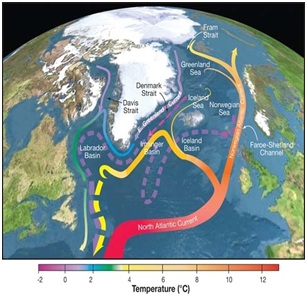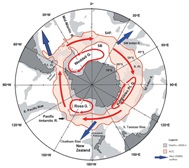Slowing down of Atlantic Ocean current system
A recent study shows that the Atlantic Meridional Overturning Circulation (AMOC) is losing its stability that would cool the northern hemisphere and decrease rainfall over Europe.
Context
A recent study shows that the Atlantic Meridional Overturning Circulation (AMOC) is losing its stability that would cool the northern hemisphere and decrease rainfall over Europe.
What is Atlantic Meridional Overturning Circulation (AMOC)?
- The AMOC is a large system of the ocean currents.
- It is the Atlantic branch of the ocean convey or belt or Thermohaline circulation (THC).
- It helps to distribute heat and nutrients throughout the world’s ocean basins.
- AMOC carries warm surface waters from tropics towards the Northern Hemisphere, where it cools and sinks.
- It then returns to tropics and then to the South Atlantic as a bottom current.
- From there it is distributed to all ocean basins via the Antarctic circumpolar current.

Thermohaline circulation (THC)
Antarctic circumpolar current
|
Why is the AMOC slowing down?
- Melting of glaciers
- High precipitation in Indian Ocean
- Global warming
Impact of the collapse of AMOC
- In absence of a proper AMOC and Gulf Stream, Europe will be very cold and without rainfall.
- Gulf Stream, a warm current, is part of the AMOC, responsible for the mild climate at the Eastern coast of North America as well as Europe.
- It can also have an impact on El Nino.
- This will cool the area over the northern North Atlantic and the neighboring areas,area over the Greenland-Iceland-Norwegian seas and to the south of Greenland, and a significant southward rain-belt migration over the tropical Atlantic.


